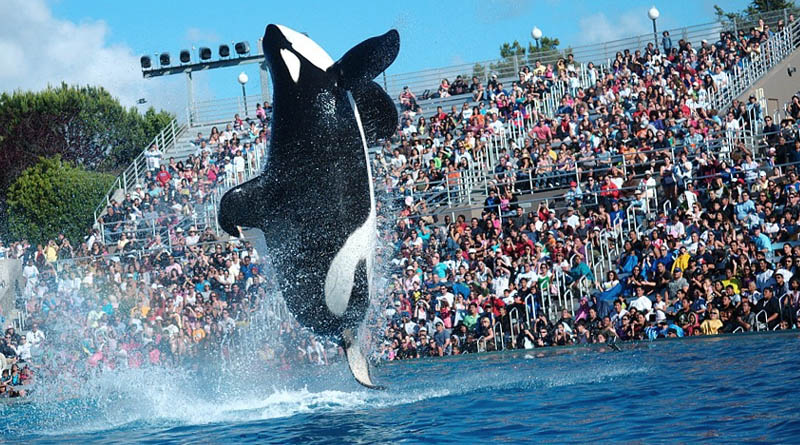ANIMAL RIGHTS AND OUR CHANGING ATTITUDES
SeaWorld has at last announced it will be phasing out its captive killer whale shows. The brand was originally built off the back of Shamu – a captive orca – in the late 1960s.
Shamu wasn’t bred in captivity – she was wild caught. Yanked out of the water, away from her family and the ocean and kept in a tank to perform for humans at SeaWorld San Diego.
She was the fourth killer whale ever captured, and the second female. She was captured in October 1965 and died in August 1971 after about six years in captivity.
Since then many, many more killer whales have lived and performed at SeaWorld parks and dozens have been bred at the parks – never knowing the freedom of the open ocean, and being forced to perform tricks for the delight of the paying crowds.
SeaWorld hasn’t caught orcas from the wild for many years – all theirs are now captive bred, but that doesn’t mean an end to the trade in wild killer whales. In 2014 two were captured in Nikolaya Gulf, in the southwestern Sea of Okhotsk, in the Russian Far East. Seven killer whales have been taken in the Sea of Okhotsk since late 2012. The overall total since 2002 currently stands at 15 orcas. (Source: http://uk.whales.org/blog/2014/08/two-orcas-taken-in-illegal-capture-in-russia)
It’s believed that many of these Russian caught orcas have been sold to theme parks in China. (Source: http://www.orcahome.de/chimelong.pdf)
There are currently a total of 56 orcas held in captivity (23 wild-captured plus 33 captive-born) in at least 12 marine parks in eight different countries. (Source: http://us.whales.org/wdc-in-action/fate-of-captive-orcas)
Although this proves that globally we still have a long way to go, it is cheering to see that SeaWorld is recognising that this is an outdated, unethical practice and has announced it will end its ‘Shamu Shows’ and its orca breeding programmes.
This means that the last generation is now in SeaWorld’s care: 29 killer whales from one to 51 years old. The company has announced all the remaining animals will be able to live out their years serving in “new, inspiring natural orca encounters, rather than theatrical shows, as part of its ongoing commitment to education, marine science research, and rescue of marine animals. These programs will focus on orca enrichment, exercise, and overall health. This change will start in its San Diego park next year, followed by San Antonio and then Orlando in 2019.”
Exactly what new, inspiring natural orca encounters” means isn’t clear yet.
SeaWorld’s decision represents a move forward in our attitude towards the rights of animals. It wasn’t that long ago, perhaps only a decade, that ending these shows would have been unthinkable. People loved them, they flocked to them, and they made companies like SeaWorld millions of dollars.
But now there is a definite shift. In 2015 there were only two zoos (Chester Zoo and ZSL London Zoo) in the top 25 of most visited attractions in the UK. (Source: http://www.alva.org.uk/details.cfm?p=423) The number of circuses with wild animals and the number of wild animals used by circuses have declined in recent years – but the government has yet to agree a total ban. This is despite a ban on wild animals in travelling circuses being a manifesto pledge of the current Conservative government.
Unfortunately, it doesn’t look likely that the Conservatives will keep this manifesto promise. I recently wrote to David Cameron asking for a ban and this was the response:
Dear Ms Cooke,
Circus Animals
Thank you for your email of 5 March to the Prime minister about the use of wild animals in travelling circuses. This has been passed to Defra as the department responsible for this policy area and I have been asked to reply.
A ban on the use of wild animals in travelling circuses is a manifesto commitment and the Government is committed to introducing a bill when parliamentary time allows.
Currently, the ban stands to impact on a small number of travelling circuses that operate with wild animals in England. During the last circus touring season, which ended in November, two travelling circuses were licensed under Defra’s interim Welfare of Wild Animals in Travelling Circuses (England) Regulations 2012 to use 18 wild animals. All circuses licensed by Defra are subject to regular announced and unannounced welfare inspections.
The licensing scheme will stay in place to ensure that any wild animals used in travelling circuses continue to be kept to a high welfare standard until a ban comes into force.
Yours sincerely,
Gary Haynes
Defra – Customer Contact Unit
Despite this rather disappointing response we should celebrate the fact that progress, overall, is being made when it comes to the rights of animals to live a natural, cruelty free life. And we should use this victory as motivation to continue the fight for improved animal welfare in the UK and abroad. Now is the time to make your voice heard; write to your MP and the Prime Minister (http://www.parliament.uk/get-involved/contact-your-mp/), if you are travelling abroad – avoid these types of captive wild animal shows and tell your hotel and tour operator that these are not suitable or acceptable tourist experiences.
ABOUT THE AUTHOR
Chantal Cooke is a professional journalist and travel writer, and co-founder of PASSION for the PLANET radio, and Panpathic Communications. Follow her on Twitter @ChantalCooke

